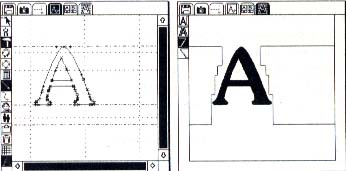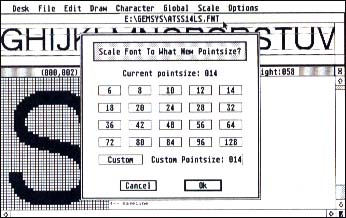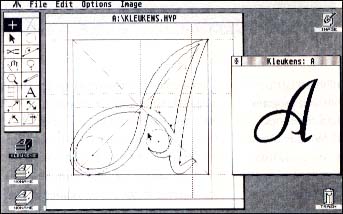Review
Three Font Editors for the ST
BY DAN FRUCHEY
You've just bought UltraPublish 3.0, the brand new desktop publishing program that slices, dices, makes Julienne fries, and shreds mounds and mounds of coleslaw. It has every option you could ever wish for, but there's one catch: The program comes with only two different font families. You can only use those two styles in so many ways before things become boring. Worse, there aren't any other fonts available. Is there a solution? Read on, frustrated font fan.
Don't expect many new fonts from the publishers of your software. It's not that they don't want to offer you more options, it's simply that the time and effort expended creating a font for the commercial market usually doesn't justify the price people are willing to pay.
But what if you want additional fonts or need special symbols that aren't defined in the fonts you own? Several companies have recognized this need and produced font editors that fill the gap. Now you can create your own stylized fonts or edit existing ones.
Font Formats
When I was asked to compare the font editors for START, I should have realized the difficulties in doing so. It's easy to compare products that are similar in nature but fonts are so product-dependent that making an exact comparison is difficult.
It's a little like comparing apples and oranges. Both are fruit and both have seeds but that's about as far as it goes. Fonts editors are similar: they're all editors and they create fonts, but beyond this the products are quite distinct. Each font editor is designed for a different font format and, if you own the associated products, you may have to buy more than one editor to meet your needs. Currently, there are two types of fonts: Outline (vector) and Bit-mapped (raster).
Outline Fonts
Outline fonts are created by aligning lines and curves and then joining them together to create a tracing of a character. The outlines can be filled, skewed, rotated, thickened and more, based on options defined later. The outlines can be resized almost endlessly and a font of almost any size can be generated.
Outline fonts are usually more versatile than bit-mapped fonts. They allow a greater range of character manipulations and consume less RAM and disk space. Unfortunately, they're not as precise as bitmapped fonts, require more time to redraw on screen and can slow printing speeds dramatically on systems with minimal RAM.
Outline fonts are usually not as portable as bit-mapped fonts. Each product uses a slightly different format that won't let you use their fonts with any other product that incorporates outline fonts. PageStream, Calamus, Ultrascript and Deskset II all use outline fonts. Three of these companies purchase fonts from the same company (Compugraphics). Yet each time you buy a program that uses outline fonts you must repurchase these fonts in a slightly different format.
 |
| On the left, ISD's Calamus Font Editor drop-down accessory. The screen features an outline for the letter A from a Souvenir font. On the right, the same A, depicted in its final form while the kerrning default is being adjusted on the letter. |
Bit-Mapped Fonts
Bit-mapped fonts are composed of individual dots that are precisely placed to give each character clear definition. Individual dots can be used for flourishes and shading schemes that are impractical or impossible in outline fonts.
Printing speeds up when a program uses bit-mapped fonts. The characters are predefined in each size and style so the computer can copy existing characters without creating new ones from scratch. Programs that use bit-mapped fonts allow very rapid onscreen editing without the use of a separate editor or the constant redraws common in programs using outline fonts.
Bit-mapped fonts are extremely portable from program to program and system to system. Most ST programs that use bitmapped fonts can use all the bit-mapped fonts available. The GDOS standard currently supported by Atari uses bit-mapped fonts. For users of 512K and one-meg systems, it's the only practical route for accessing fonts.
The biggest drawback of bit-mapped fonts is size availability. Since each font is limited to a predefined size you're also limited to certain types of applications. Most manufacturers of fonts limit their size selection to 8, 10, 12, 14, 18 and 24 point sizes. The fonts can't be rotated, filled or styled like outline fonts. If you need a rotated font, you have to buy a rotated font--which is virtually impossible to find.
Bit-mapped fonts, most of which follow the GDOS format established by Atari and DRI, are used by Easy Draw, Timeworks Publisher, Fleet Street Publisher, Microsoft Write, WordUp, DEGAS Elite and many ocher programs.
The Font Editors
Both outline and bit-mapped font editors are represented here. In addition, one of the editors creates bit-mapped fonts using a twist that brings the best of both worlds together. Listed below are overall summaries of each product with remarks about options that make a particular product unique or distinct.
A chart is also included that lists significant program options that are similar throughout all three products.
 |
| Fontz! allows automatic conversion to any point size desired, includ- ing many predefined sizes. Shown here is a Swiss font about to be converted to another size. |
Calamus Font Editor
The Calamus Font Editor is the only one presented here that creates outline fonts. It's actually a desk accessory that you can use to make immediate changes to fonts while working within the Calamus desktop publishing program from ISD Marketing. The program interface is heavily icon-oriented, but that will be familiar ground to Calamus users--the icons are equivalent to those used in Calamus whenever possible. Usually font editors are produced by third party developers once the product is in great demand, but the early introduction of a font editor by ISD should help sell Calamus to many users.
The editor includes a utility to import pictures as templates that can be traced while creating fonts. For precision placement of lines and curves, the location of the cursor is displayed and updated constantly on screen. There's even a calculator that allows automatic and manual manipulation of characters for rotation, skewing, mirroring and other style changes.
Fontz!
Fontz! from Neocept has virtually become the standard for manipulation and importation of bit-mapped GDOS fonts. Last year several manufacturers were in the process of producing a bit-mapped font editor, but the completeness of Fontz! has made any similar product unnecessary.
Although Fontz! is easy to use, expect to spend many hours smoothing out lines and curves generated with this product. Each pixel must be placed in the right location or else characters will look lopsided or ungainly. Each time a new size is generated the characters must once again be smoothed to appear the best for that particular size and resolution.
To save your sanity I recommend purchasing this product along with Hyperfont. Create the fonts with Hyperfont and then perform minor changes and convert formats using Fontz!
 |
| The unique Hyperfont "Desktop." The outline form for the letter A is depicted along with the actual results when the font is completed to the right of it. |
The ability to import fonts from other systems makes Fontz! an invaluable addition for anyone who requires a wide range of fonts. In one day I was able to quadruple my font library by importing styles from other systems.
Hyperfont
Hyperfont, MichTron's addition to the market, is a unique blend that uses some of the best aspects of both outline and bit-mapped fonts.
Hyperfont creates bit-mapped GDOS fonts, but it uses a unique approach. When fonts are created, it's not necessary to follow the cumbersome dot-by-dot approach normally used for creating bit-mapped fonts. Instead, an outline is created similar to the type generated by the Calamus Font Editor. Once a font has been created, you indicate the size and device the font is intended for and Hyperfont generates a bit-mapped font for that specific need.
Hyperfont uses its own special Desktop (similar to the one used by GEM). You can open windows that contain fonts or an image file by double-clicking on icons. A trash can and a specialized file selector box are also present. Hyperfont's familiar operating environment makes it easy to use without constantly referring to the manual.
Like the Calamus font editor, Hyperfont imports pictures for use as tracing templates when creating fonts. One element that may limit the versatility of this program is it's inability to edit fonts it creates. Once a font is generated you need a GDOS font editor such as Fontz! to perform any additional detail work.
|
||||||||||||||||||||||||||||||||||||||||||||||||||||||||||||||||||||||||||||||||||||||||||||||||||||||||||||||||
Final Thoughts
Perhaps you don't plan to create your own fonts, perhaps you're not sure use of a font editor will be productive. Let me make one final point: regardless of whether you use the editor, there is another positive aspect.
Each product comes with a variety of predefined fonts that you can use in your programs immediately. Each of the packages is well worth the purchase price simply for the fonts. If you use the editor, great; if not, you still haven't lost anything and even a single typeface can make a world of difference.
Dan Fruchey works as a paramedic in Santa Rosa, California and runs a small clip-art business on the side.
PRODUCTS MENTIONED
Calamus Font Editor, $99.95. ISD Marketing, Inc. 2651 John Street, Unit 3, Markham, Ontario, Canada L3R 2W5, (416) 479-1880.
Fontz!, $34.95. Neocept 547-A Constitution Avenue, Camarillo, CA 93010, (805) 482-4446, (805) 482-0313 (technical support).
Hyperfont, $49.95. MichTron, Inc., 576 South Telegraph, Pontiac, Michigan 48053, (313) 334 5700.